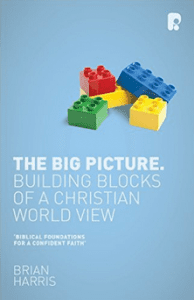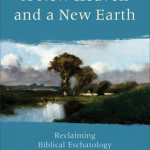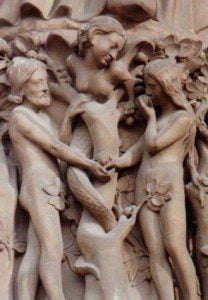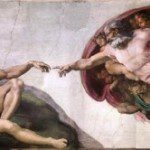 On Tuesday we looked at the first half of chapter two of J. Richard Middleton’s book The Liberating Image: The Imago Dei in Genesis 1. In this half Middleton concluded that Genesis 1 intentionally conveys a royal metaphor for God as creator, but this is a complex metaphor and must not be understood as a simple one-dimensional portrait of God.
On Tuesday we looked at the first half of chapter two of J. Richard Middleton’s book The Liberating Image: The Imago Dei in Genesis 1. In this half Middleton concluded that Genesis 1 intentionally conveys a royal metaphor for God as creator, but this is a complex metaphor and must not be understood as a simple one-dimensional portrait of God.
Superimposed on and integrated with the picture of God speaking creation into being is the metaphor of God as designer and artificer, constructing with care, attention, obvious pleasure, and self-investment (as a good artist) a coherent, harmoniously functioning cosmos, according to a well-thought-out plan. This characterization of God as maker or artisan is rhetorically embodied in the superb literary artistry of the creation story, which moves from a preparatory statement in 1:1-2 through six “days” of God’s work, to the seventh climactic day (2:1-3) when God “rests” (sabat), satisfied, having completed his work. (p. 74)
Much is often made of the fact that Genesis 1 is prose, not poetry. Poetry is figurative, while prose, it is implied, leads inevitably to the conclusion that the text is providing a factual, newspaper report-like account of creation. But Middleton points out that Genesis 1 is an artistically designed piece of literature. One level of the literary artistry of Genesis 1 is illustrated in the figure above. There are two triads of creation with spaces or realms created in days 1 through 3 and filled in days 4 through 6. This structure has been recognized for some 300 years at least, and in a somewhat modified form well before that (separation and adornment based on the form of the Vulgate translation or mistranslation). Middleton suggests that the literary structure may extend to the preparatory and concluding passages as well. (I’ve modified slightly and added color to Figure 4, p. 75)
The text, then, by its careful literary artistry, evokes a creator-God carefully constructing an artful world according to a well-thought-out plan for the benefit of creatures. (p. 77)
Creation as Cosmic Temple. The language of Genesis 1 also evokes an image of building, that is the construction of a stable concrete structure. Middleton looks at the language used in a number of creation texts in Job, Proverbs, and Psalms as evidence alongside Genesis 1 for a worldview that understood creation as a structure formed as God’s temple. Isaiah 66 1-2 is another example (along with other passages in Isaiah). According to Middleton this passage calls into question attempts to rebuild the temple in Jerusalem.
Thus says YHWH:
Heaven is my throne,
and earth is my footstool.
Where could you build a house for me?
What place could serve as my dwelling?
All this was made by my hand,
and thus it all came into being
– declares YHWH.
God has no need for a man made temple because he has already constructed a cosmic temple for himself.
And this sanctuary in which God dwells is also portrayed as God’s palace from which God reigns – hence the language of throne and footstool. The cosmic temple, in other words, is clearly the equivalent to God’s kingdom. (p. 82)
Likewise God will create the new heavens and new earth of Isaiah 65 and 66.
The superabundance of sevens. Middleton points as well to the sevenfold structure of Genesis 1. There are seven days of creation, seven execution reports (it was so) and seven evaluation reports (it was good). The literary structure of sevens extends deeper into the artistry of the text – there are multiples of seven throughout the text: 5×7 occurrences of God, 3×7 of earth, 67×7 for the whole text, 3×7 in the preparatory preamble (1:1-2), and 5×7 in the description of the seventh day. This could be coincidence, but those who study such things in ancient literature tend to think it unlikely. Middleton concludes that the sevenfold structure “seems to have cultic, liturgical significance and may well be associated in some way with the Jerusalem temple.” (p. 83)
Humanity as God’s image. The focus of chapter two is the imago Dei in the symbolic world of Genesis 1. According to Middleton Genesis 1, immersed in the symbolic world of the ancient Near Eastern culture, evokes images of God as king and creation as his kingdom, God as artisan and creation as his handiwork, and God as, well, God and creation as his cosmic temple. All three of these have implications for the meaning of the imago Dei.
1. There is a royal-functional facet of the image. “[H]umans are like God in exercising royal power on earth … the divine ruler delegated to humans a share in his rule of the earth.” (p. 88)
2. There is a creative aspect to the image. “God has … started the process of forming and filling, which humans as God’s earthly delegates, are to continue. (p. 89)
3. There is a priestly dimension to the image. “In the cosmic sanctuary of God’s world, humans have pride of place and supreme responsibility, not just as royal stewards and cultural shapers of the environment, but (taking seriously the temple imagery) as priests of creation, actively mediating divine blessing to the nonhuman world. (p. 90)
The claim of Genesis 1:26-28 that mankind was created, male and female, in the image of God includes all three of these roles – royal, creative, and priestly. Given this three-fold role for humans as the image and likeness of God, the fall has profound consequences. Middleton alludes to this in the text – but becomes more explicit in a footnote (Middleton has many interesting footnotes).
Indeed, we may say that due to the disobedience of humanity (God’s priestly representatives on earth) the divine presence does not fully indwell the world. We thus await the day when God’s glorious presence will redemptively fill the earth “as the waters cover the sea” (Isaiah 11:9; Habakkuk 2:14). (p. 90)
Do you find Middleton convincing that the image includes royal, creative, and priestly roles? Why or why not?
If you wish to contact me directly you may do so at rjs4mail [at] att.net.
If interested you can subscribe to a full text feed of my posts at Musings on Science and Theology.











